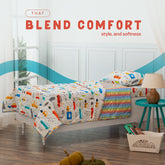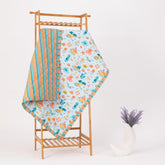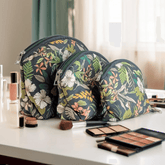Best Sensory Kits for Autism: Complete Guide for Parents
Every parent wants for their child to be content, interested, and at ease. Finding the appropriate resources to meet the sensory demands of autistic children can be a daunting task. An autistic sensory kit is a useful tool that makes everyday living more enjoyable and comfortable. These specifically created kits allow kids to play and enjoy themselves while improving their ability to comprehend sensory information.
Through sensory play kits, difficult situations may be turned into chances for development and bonding. They give kids structured, secure opportunities to learn important life skills and explore their surroundings.
Understanding Sensory Challenges in Autism
Children with autism frequently have distinct sensory experiences of the environment. Commonplace lighting, sounds, and textures might seem unimpressive or overbearing. Their everyday activities and emotional health are impacted by these particular difficulties.
Common Sensory Issues
Hypersensitivity makes children avoid certain textures, sounds, or movements. They might cover their ears during loud noises or refuse to touch certain materials. These reactions happen because their nervous system processes sensory input more intensely.
Hyposensitivity means children need more sensory input to feel satisfied. They might seek out strong textures, loud sounds, or intense movements. These children often appear to have endless energy and crave sensory experiences.
Sensory Seeking Behaviors include spinning, jumping, or touching everything. Children use these behaviors to get the sensory input their bodies need. Understanding these behaviors helps parents support their child's needs effectively.
Daily Life Impact
Sensory challenges affect many aspects of daily life. Morning routines become difficult when clothing feels uncomfortable. Mealtimes turn stressful when food textures create anxiety. Social situations become overwhelming when sounds and movements feel too intense.
These challenges can lead to meltdowns, withdrawal, or behavioral issues. Children aren't being difficult - they're trying to cope with overwhelming sensory experiences.
The Power of Sensory Kit Play for Autism
Children can explore and comprehend their sensory environment in an organized manner through sensory play, having fun while learning coping mechanisms. Sensory integration therapy, such as this, promotes overall growth and sensory processing.
Benefits of Sensory Play in Dealing Autism
Emotional Regulation improves when children have positive sensory experiences. They learn to identify what feels good and what doesn't. This awareness helps them communicate their needs better.
Social Skills develop naturally during sensory play. Children learn to share materials, take turns, and communicate with others. These skills transfer to other social situations.
Cognitive Development happens through hands-on exploration. Children learn cause and effect, problem-solving, and creative thinking. Sensory play engages multiple areas of the brain simultaneously.
Motor Skills improve through manipulation of different materials. Fine motor skills develop through activities like pouring, pinching, and sorting. Gross motor skills improve through movement-based sensory activities.
Why Sensory Kits Work
Sensory kits provide organized, accessible sensory experiences. They remove the guesswork from sensory play by including carefully selected materials. Parents can use these kits confidently without wondering if activities are appropriate.
The structured nature of kits helps children feel secure. They know what to expect and can anticipate the sensory experiences. This predictability reduces anxiety and increases engagement.
Essential Components of Autism Sensory Kits
Materials for effective sensory kits cater to various sensory requirements. They offer variation without sacrificing safety or order.
|
Tactile Materials |
Visual Stimulation Tools |
Auditory Components |
Proprioceptive Tools |
|
Textured fabrics offer safe ways to explore different feels. Smooth satin, bumpy corduroy, and soft fleece provide varied tactile experiences. Children can touch, rub, or hold these materials for comfort. |
Light-up toys provide calming visual input. Fiber optic lights, LED toys, and glow sticks create fascinating visual experiences. These tools help children who seek visual stimulation. |
Sound-making toys help children explore auditory processing. Musical instruments, sound tubes, and cause-and-effect toys provide auditory feedback. These tools help children understand sound relationships. |
Autism calming toys like weighted lap pads, compression vests, and heavy items provide deep pressure therapy to help children feel grounded. This input helps regulate the nervous system. |
|
Fidget toys help children focus and self-regulate. Stress balls, textured strips, and squishy toys provide proprioceptive input. These tools help children stay calm during challenging situations. |
Color-changing materials engage visual processing skills. Mood rings, color-changing putty, and thermochromic materials provide surprising visual feedback. Children enjoy predicting and observing these changes. |
Noise-reducing tools support children sensitive to sounds. Noise-canceling headphones, white noise machines, and quiet spaces help manage overwhelming auditory input. |
Resistance tools help children get proprioceptive feedback. Therapy putty, resistance bands, and push-pull toys provide muscle input. These activities help children understand their body position |
Themed Sensory Play Kits
Themed sensory kits enhance daily activities with excitement, creative play, and early learning opportunities. These kits encourage children's curiosity and foster their developmental progress by fusing known concepts with hands-on discovery. Let's discuss a few examples that help children with autism identify things in real life.
Construction Theme Sensory Kit
Proprioceptive and tactile input is provided by building materials. A dynamic and enjoyable play experience is offered by foam blocks, textured panels, gritty bricks, and miniature construction trucks. Children gain the sensory input necessary for fine motor abilities while learning to construct buildings.

Children can safely experiment with construction concepts by using realistic tool reproductions. Kids may practice problem-solving and cause-and-effect by acting out real-life scenarios using tools like plastic hammers, toy screwdrivers, and measuring tapes.
Surfaces with texture mimic real building materials. Corrugated cardboard, soft foam, bubble wrap blocks, and sandpaper strips offer contrasting tactile sensations. These textures keep play safe and interesting while improving touch discrimination.
Farm Animal Theme Sensory Kit
Imaginative play is facilitated by animal figurines. Realistic noises, realistic farm animals, and animal habitats combine to create captivating scenes. A child with Autism can engage in sensory play while simulating agricultural life.

Check Out Motor Learning Farm Animal Sensory Kit
Natural materials help kids relate to rural settings. Pieces of wood, dried maize, and hay offer real tactile pleasures. These resources aid kids in using their senses to comprehend agricultural life. Both tactile inquiry and sensory control are encouraged by these textures.
Farm noises enhance auditory processing abilities. Aural stimulation is provided via animal sound toys, recordings of farm environments, and melodies that link sounds to visual signals. Youngsters may associate activities and animals with sounds.
Want to simplify your child’s sensory routine? Explore ready-made sensory kits for Kids
Ocean Theme Sensory Kit
The soothing sensory modulation that the sea theme encourages is particularly advantageous for kids with autism. Squishy toys with ocean themes, gel-like water beads, and cool blue rice are examples of materials that provide soothing tactile input that can help kids focus better during play, lower anxiety, and self-soothe.

For kids on the autistic spectrum, sea creature miniatures promote fine motor skills and imaginative storytelling, two important areas of assistance. Through interactive play with an ocean theme, children may develop their descriptive language, sequencing abilities, and creative thinking while also being stimulated by the tactile sensations of smooth starfish, textured coral pieces, and elastic jellyfish toys.
Choosing the Right Sensory Kit
Selecting the best sensory kit depends on your child's specific needs and preferences. Consider their sensory profile, interests, and developmental level.
Understand Sensory Requirements
Pay attention to your child's inclinations and dislikes. Take note of the textures they prefer or shun. Observe their reactions to various lighting, noises, and motions. The choice of kit is guided by this information.
Think about the differences between sensory-avoiding and sensory-seeking behaviors. While some kids want softer experiences, others require more intensive sensory input. Select kits based on the sensory profile of your kid.
Consider the safety regulations. Make sure every material is non-toxic and suitable for the child's age. When choosing materials, take into account your child's propensity to mouth items.
Age and Development Considerations
Younger children need larger materials that prevent choking hazards. Choose kits with simple activities and clear boundaries. Focus on basic sensory exploration rather than complex tasks.
Older children can handle more complex activities and smaller materials. Look for kits that challenge problem-solving skills while providing sensory input. Consider their academic interests and hobbies.
Using Sensory Kits Effectively
Successful sensory kit use requires planning and observation. Start slowly and follow your child's lead.

Conclusion
You can assist your child's sensory requirements with the help of an autism sensory kit. These kits turn obstacles in daily life into chances for happiness and personal development. Children may safely and confidently explore their surroundings with the help of carefully chosen materials and themed activities.
Never forget that each child is different. A child may not benefit from something that works for another. Trust your gut and your child's reactions as you both experiment with various senses.
Choose one kit at first, based on your child's interests and sensory preferences. See how people react, then make the necessary adjustments. With time and effort, sensory kits may evolve into effective resources for promoting your child's growth and learning.










